Abstract
Complement receptor 1 (CR1) on primate red blood cells (RBC) binds most complement-fixing immune complexes in the circulation. It has been postulated that by binding them, RBC keep immune complexes in the intravascular space and deliver them to the tissue macrophages of the mononuclear phagocyte system. We have developed an in vitro model to study the transfer of RBC-bound immune complexes (heat-aggregated IgG and DNA-anti-DNA) to phagocytic cells (human monocytes). Transfer of immune complexes from RBC to monocytes occurred significantly more rapidly than monocyte uptake of the same immune complexes from solution. In the transfer process, complex-bearing RBC were not bound or sequestered by the monocytes. To define the monocyte receptors involved in binding immune complexes from the RBC surface, monocyte receptors were blocked with MoAbs (anti-CR1, anti-FcRII) or EDTA (to block CR3). Monocyte binding of immune complexes primarily used CR1 with a small contribution from FcRII, and with little or no contribution from CR3 and FcRI. Uptake of immune complexes from solution employed the same monocyte receptors as binding of complexes from the RBC surface. Immune complexes in solution bound to RBC and to monocytes with equally high avidity (approximately 1 x 10(11) l/M), but monocytes expressed a 15-20-fold greater number of immune complex binding sites. We propose that immune complexes distribute between RBC and monocytes according to the binding capacity of these cells, such that at equal or high RBC/monocyte ratios as would be seen in the circulation immune complexes bind to RBC, but at low RBC/monocyte ratios (as would be seen in the sinusoidal circulation of the liver and spleen), most immune complexes bind to monocytes. To define the pathway by which immune complexes move from RBC to monocytes, their release from RBC CR1 was examined. Under various conditions, the dissociation rate was extremely slow, and did not increase with the addition of monocyte supernatants. To examine whether factor I-mediated processing of immune complexes enhances binding of immune complexes to monocytes, RBC-bound complexes were released with factor I, and binding of these 'processed' immune complexes to monocytes was examined. Monocyte binding of these processed immune complexes was slower than of control ones; furthermore, performance of transfer experiments at 4 degrees C, which significantly shows enzymatic processes, did not decrease the rate of immune complex transfer from RBC to monocytes.(ABSTRACT TRUNCATED AT 400 WORDS)
Full text
PDF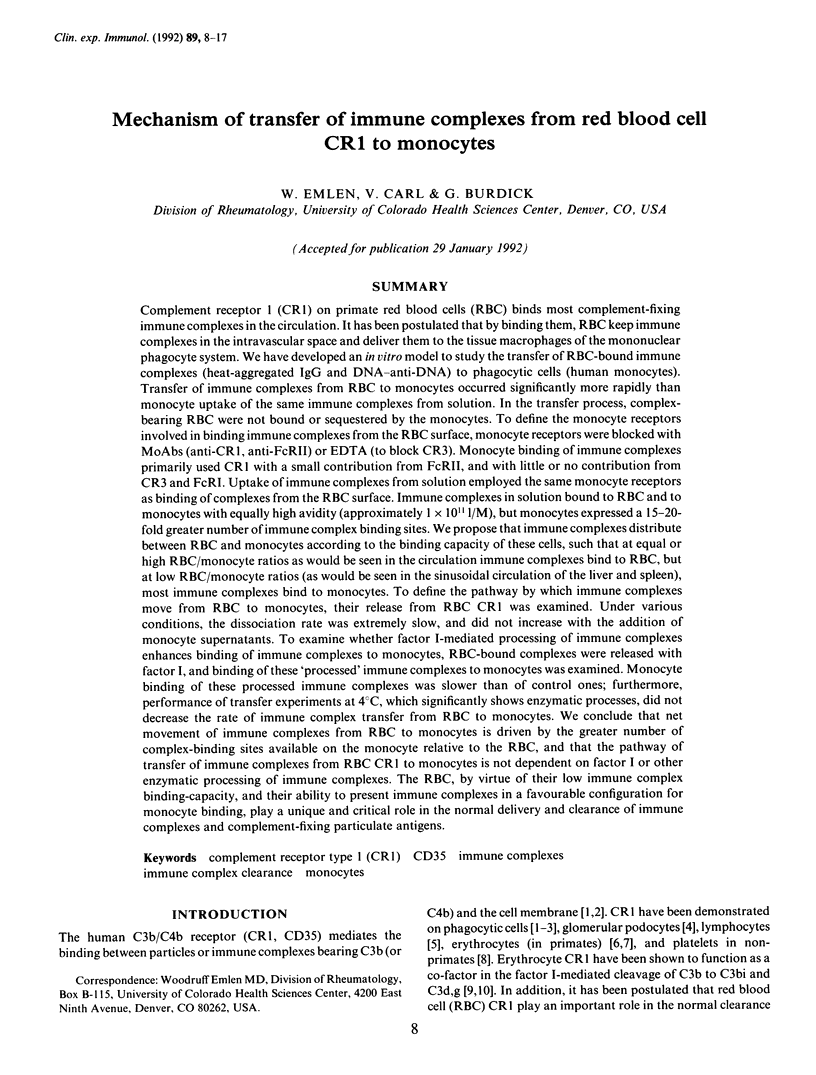
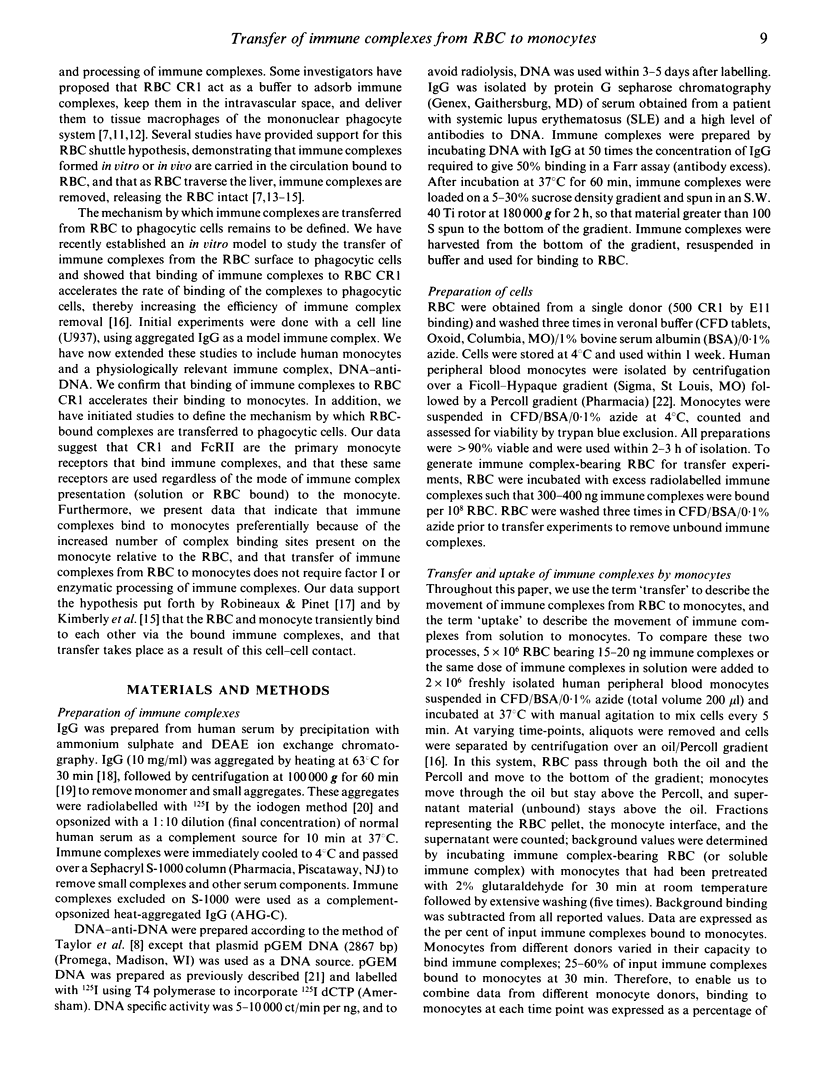
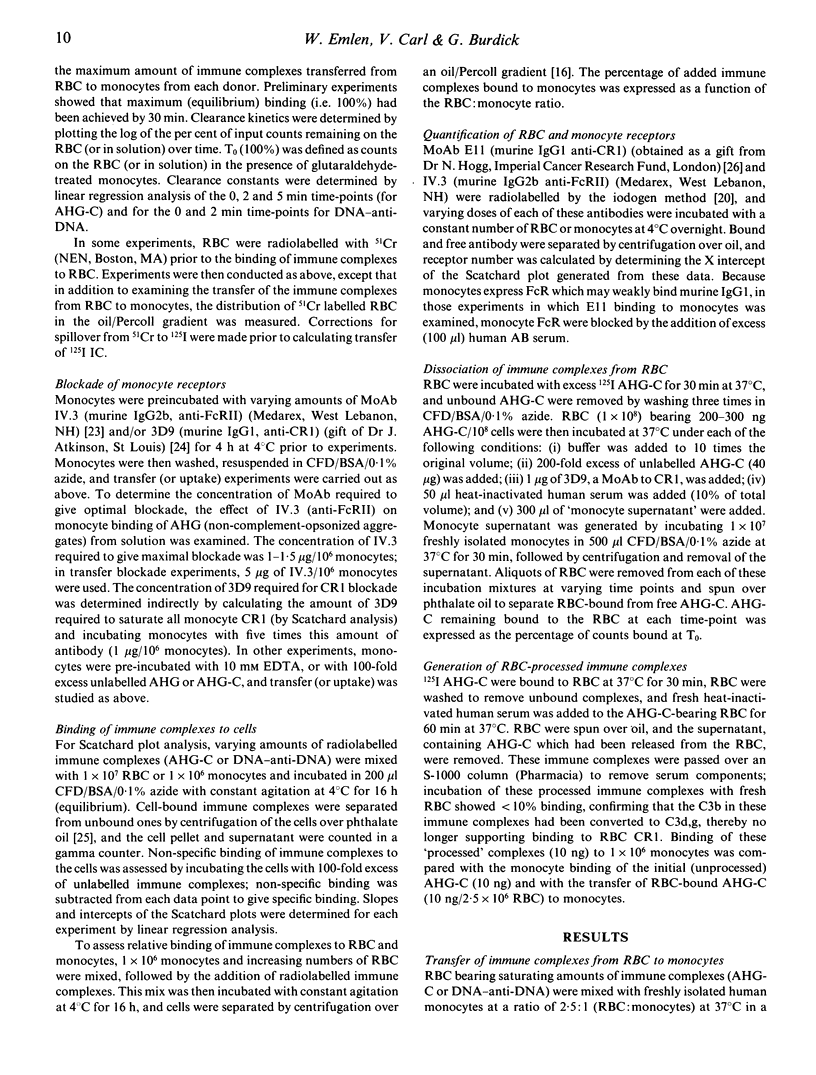
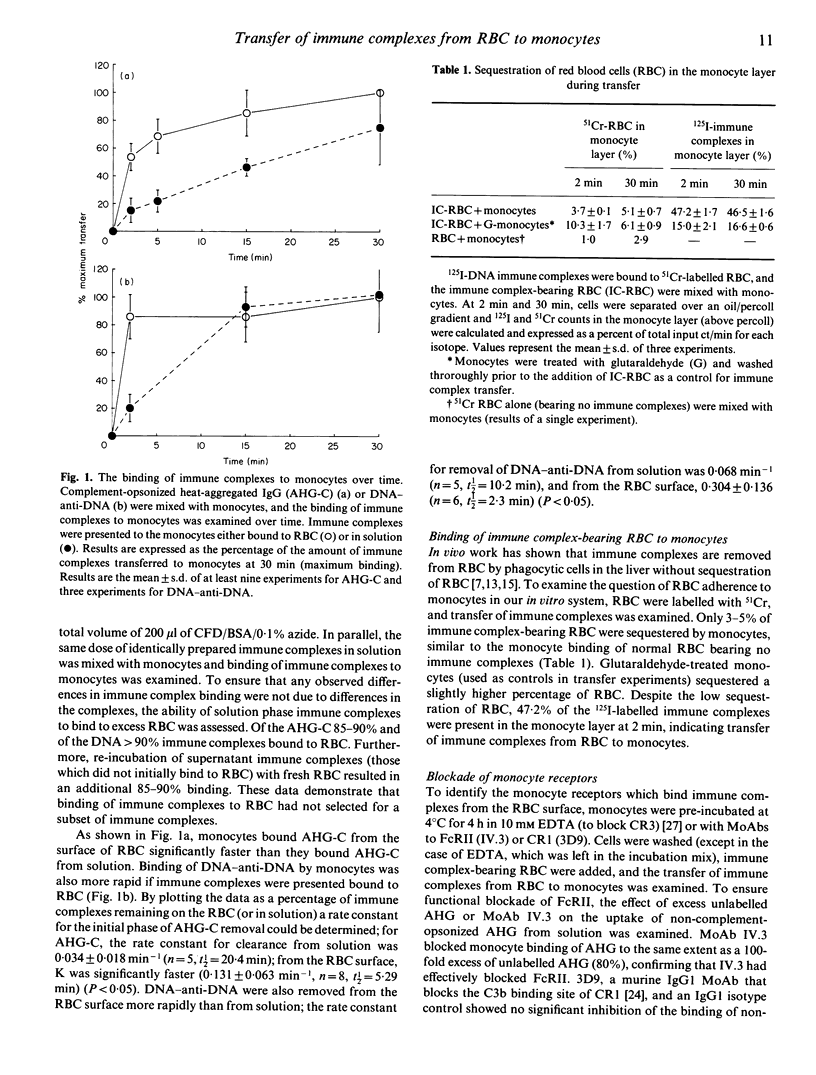
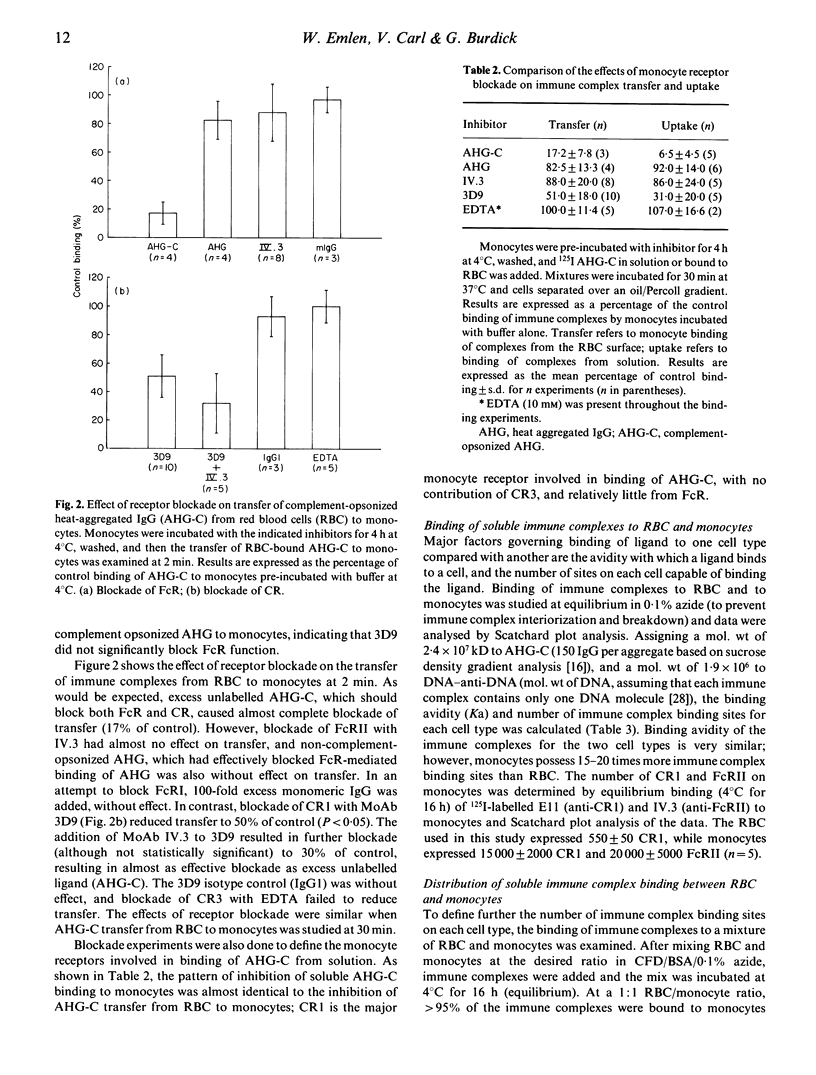
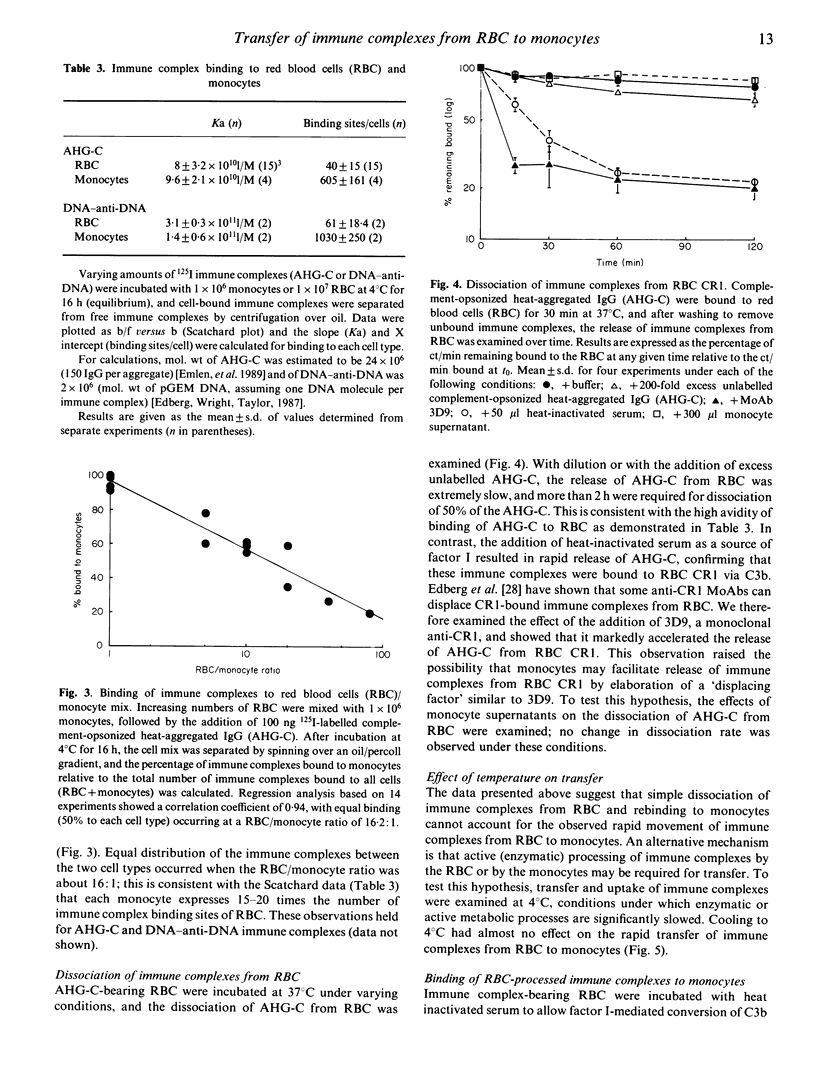
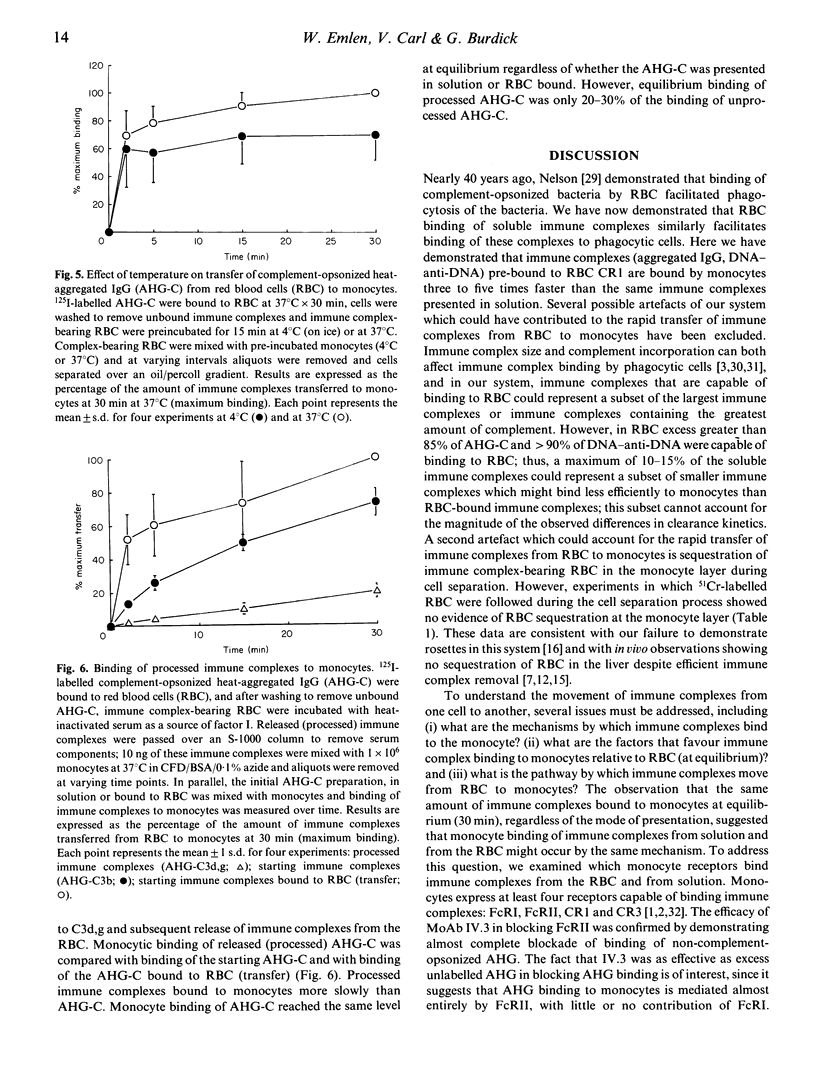
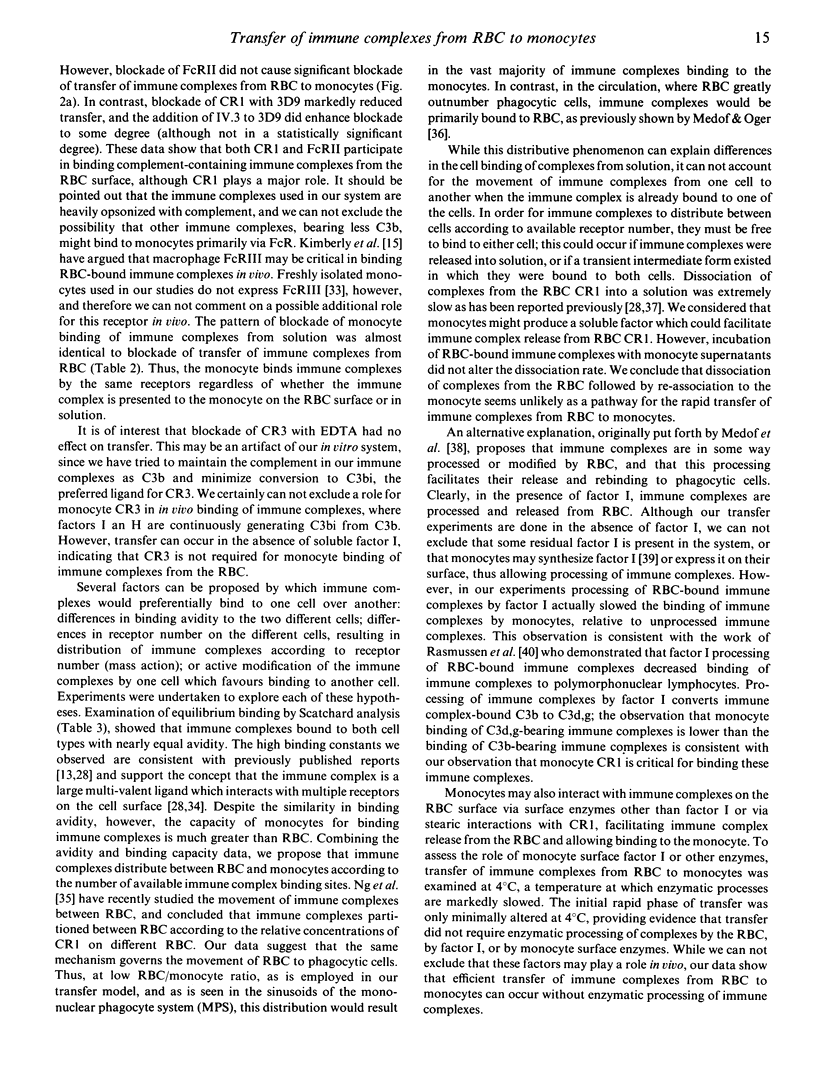
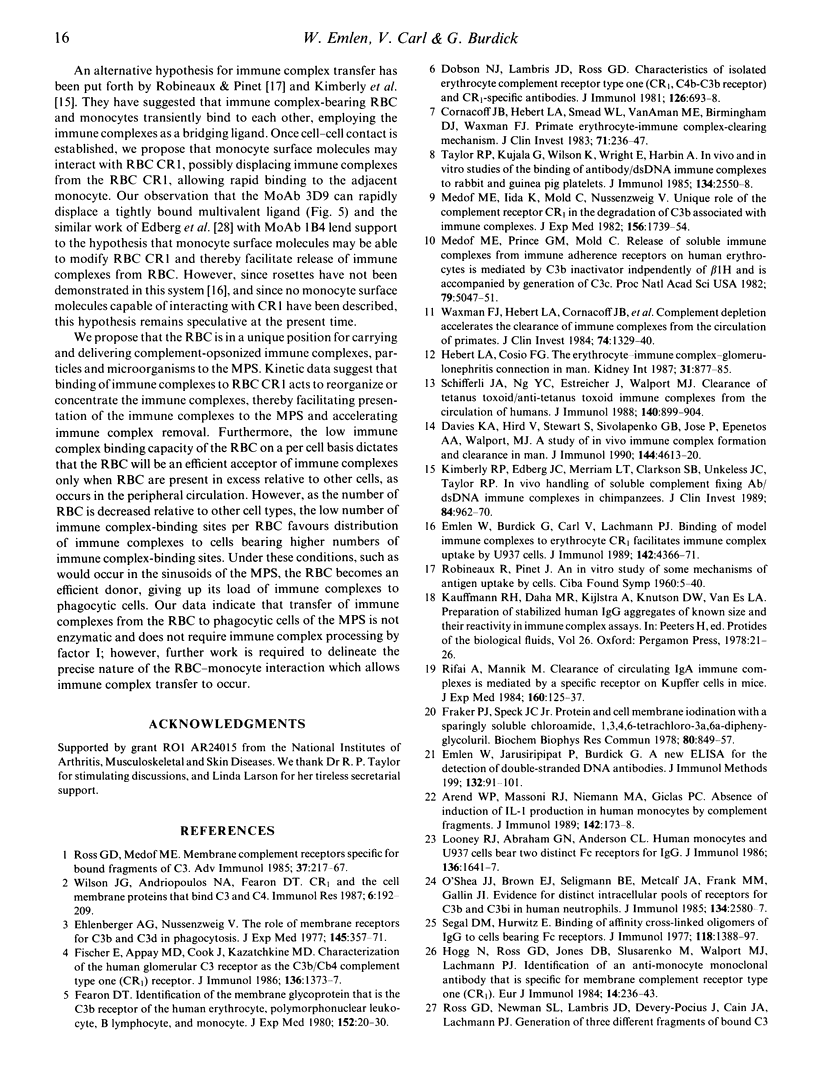
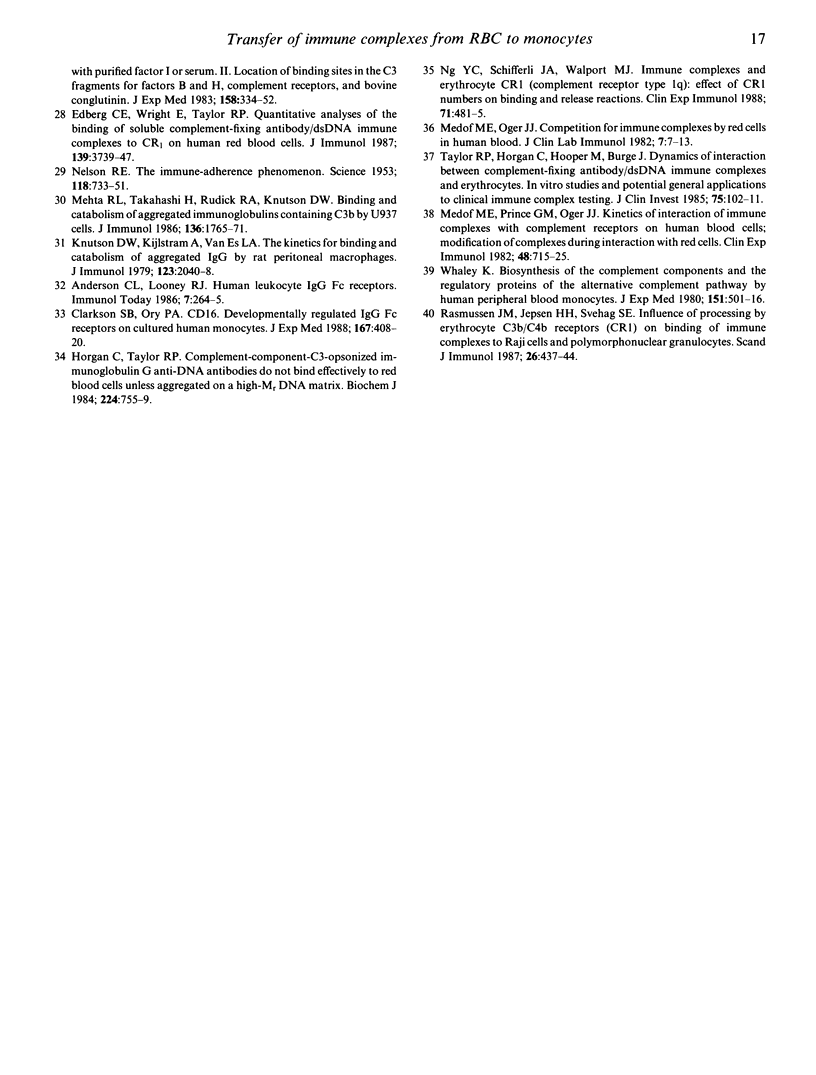
Selected References
These references are in PubMed. This may not be the complete list of references from this article.
- Arend W. P., Massoni R. J., Niemann M. A., Giclas P. C. Absence of induction of IL-1 production in human monocytes by complement fragments. J Immunol. 1989 Jan 1;142(1):173–178. [PubMed] [Google Scholar]
- Clarkson S. B., Ory P. A. CD16. Developmentally regulated IgG Fc receptors on cultured human monocytes. J Exp Med. 1988 Feb 1;167(2):408–420. doi: 10.1084/jem.167.2.408. [DOI] [PMC free article] [PubMed] [Google Scholar]
- Cornacoff J. B., Hebert L. A., Smead W. L., VanAman M. E., Birmingham D. J., Waxman F. J. Primate erythrocyte-immune complex-clearing mechanism. J Clin Invest. 1983 Feb;71(2):236–247. doi: 10.1172/JCI110764. [DOI] [PMC free article] [PubMed] [Google Scholar]
- Davies K. A., Hird V., Stewart S., Sivolapenko G. B., Jose P., Epenetos A. A., Walport M. J. A study of in vivo immune complex formation and clearance in man. J Immunol. 1990 Jun 15;144(12):4613–4620. [PubMed] [Google Scholar]
- Dobson N. J., Lambris J. D., Ross G. D. Characteristics of isolated erythrocyte complement receptor type one (CR1, C4b-C3b receptor) and CR1-specific antibodies. J Immunol. 1981 Feb;126(2):693–698. [PubMed] [Google Scholar]
- Edberg J. C., Wright E., Taylor R. P. Quantitative analyses of the binding of soluble complement-fixing antibody/dsDNA immune complexes to CR1 on human red blood cells. J Immunol. 1987 Dec 1;139(11):3739–3747. [PubMed] [Google Scholar]
- Ehlenberger A. G., Nussenzweig V. The role of membrane receptors for C3b and C3d in phagocytosis. J Exp Med. 1977 Feb 1;145(2):357–371. doi: 10.1084/jem.145.2.357. [DOI] [PMC free article] [PubMed] [Google Scholar]
- Emlen W., Burdick G., Carl V., Lachmann P. J. Binding of model immune complexes to erythrocyte CR1 facilitates immune complex uptake by U937 cells. J Immunol. 1989 Jun 15;142(12):4366–4371. [PubMed] [Google Scholar]
- Fearon D. T. Identification of the membrane glycoprotein that is the C3b receptor of the human erythrocyte, polymorphonuclear leukocyte, B lymphocyte, and monocyte. J Exp Med. 1980 Jul 1;152(1):20–30. doi: 10.1084/jem.152.1.20. [DOI] [PMC free article] [PubMed] [Google Scholar]
- Fischer E., Appay M. D., Cook J., Kazatchkine M. D. Characterization of the human glomerular C3 receptor as the C3b/C4b complement type one (CR1) receptor. J Immunol. 1986 Feb 15;136(4):1373–1377. [PubMed] [Google Scholar]
- Fraker P. J., Speck J. C., Jr Protein and cell membrane iodinations with a sparingly soluble chloroamide, 1,3,4,6-tetrachloro-3a,6a-diphrenylglycoluril. Biochem Biophys Res Commun. 1978 Feb 28;80(4):849–857. doi: 10.1016/0006-291x(78)91322-0. [DOI] [PubMed] [Google Scholar]
- Hebert L. A., Cosio G. The erythrocyte-immune complex-glomerulonephritis connection in man. Kidney Int. 1987 Apr;31(4):877–885. doi: 10.1038/ki.1987.81. [DOI] [PubMed] [Google Scholar]
- Hogg N., Ross G. D., Jones D. B., Slusarenko M., Walport M. J., Lachmann P. J. Identification of an anti-monocyte monoclonal antibody that is specific for membrane complement receptor type one (CR1). Eur J Immunol. 1984 Mar;14(3):236–243. doi: 10.1002/eji.1830140307. [DOI] [PubMed] [Google Scholar]
- Horgan C., Taylor R. P. Complement-component-C3-opsonized immunoglobulin G anti-DNA antibodies do not bind effectively to red blood cells unless aggregated on a high-Mr DNA matrix. Biochem J. 1984 Dec 15;224(3):755–759. doi: 10.1042/bj2240755. [DOI] [PMC free article] [PubMed] [Google Scholar]
- Kimberly R. P., Edberg J. C., Merriam L. T., Clarkson S. B., Unkeless J. C., Taylor R. P. In vivo handling of soluble complement fixing Ab/dsDNA immune complexes in chimpanzees. J Clin Invest. 1989 Sep;84(3):962–970. doi: 10.1172/JCI114259. [DOI] [PMC free article] [PubMed] [Google Scholar]
- Knutson D. W., Kijlstra A., van Es L. A. The kinetics for binding and catabolism of aggregated IgG by rat peritoneal macrophages. J Immunol. 1979 Nov;123(5):2040–2048. [PubMed] [Google Scholar]
- Looney R. J., Abraham G. N., Anderson C. L. Human monocytes and U937 cells bear two distinct Fc receptors for IgG. J Immunol. 1986 Mar 1;136(5):1641–1647. [PubMed] [Google Scholar]
- Medof M. E., Iida K., Mold C., Nussenzweig V. Unique role of the complement receptor CR1 in the degradation of C3b associated with immune complexes. J Exp Med. 1982 Dec 1;156(6):1739–1754. doi: 10.1084/jem.156.6.1739. [DOI] [PMC free article] [PubMed] [Google Scholar]
- Medof M. E., Oger J. J. Competition for immune complexes by red cells in human blood. J Clin Lab Immunol. 1982 Jan;7(1):7–13. [PubMed] [Google Scholar]
- Medof M. E., Prince G. M., Mold C. Release of soluble immune complexes from immune adherence receptors on human erythrocytes is mediated by C3b inactivator independently of Beta 1H and is accompanied by generation of C3c. Proc Natl Acad Sci U S A. 1982 Aug;79(16):5047–5051. doi: 10.1073/pnas.79.16.5047. [DOI] [PMC free article] [PubMed] [Google Scholar]
- Medof M. E., Prince G. M., Oger J. J. Kinetics of interaction of immune complexes with complement receptors on human blood cells: modification of complexes during interaction with red cells. Clin Exp Immunol. 1982 Jun;48(3):715–725. [PMC free article] [PubMed] [Google Scholar]
- Mehta R. L., Takahashi H., Rudick R. A., Knutson D. W. Binding and catabolism of aggregated immunoglobulins containing C3b by U937 cells. J Immunol. 1986 Mar 1;136(5):1765–1771. [PubMed] [Google Scholar]
- NELSON R. A., Jr The immune-adherence phenomenon; an immunologically specific reaction between microorganisms and erythrocytes leading to enhanced phagocytosis. Science. 1953 Dec 18;118(3077):733–737. doi: 10.1126/science.118.3077.733. [DOI] [PubMed] [Google Scholar]
- Ng Y. C., Schifferli J. A., Walport M. J. Immune complexes and erythrocyte CR1 (complement receptor type 1): effect of CR1 numbers on binding and release reactions. Clin Exp Immunol. 1988 Mar;71(3):481–485. [PMC free article] [PubMed] [Google Scholar]
- O'Shea J. J., Brown E. J., Seligmann B. E., Metcalf J. A., Frank M. M., Gallin J. I. Evidence for distinct intracellular pools of receptors for C3b and C3bi in human neutrophils. J Immunol. 1985 Apr;134(4):2580–2587. [PubMed] [Google Scholar]
- Rasmussen J. M., Jepsen H. H., Svehag S. E. Influence of processing by erythrocyte C3b/C4b receptors (CR1) on binding of immune complexes to Raji cells and polymorphonuclear granulocytes. Scand J Immunol. 1987 Oct;26(4):437–444. doi: 10.1111/j.1365-3083.1987.tb02276.x. [DOI] [PubMed] [Google Scholar]
- Rifai A., Mannik M. Clearance of circulating IgA immune complexes is mediated by a specific receptor on Kupffer cells in mice. J Exp Med. 1984 Jul 1;160(1):125–137. doi: 10.1084/jem.160.1.125. [DOI] [PMC free article] [PubMed] [Google Scholar]
- Ross G. D., Medof M. E. Membrane complement receptors specific for bound fragments of C3. Adv Immunol. 1985;37:217–267. doi: 10.1016/s0065-2776(08)60341-7. [DOI] [PubMed] [Google Scholar]
- Ross G. D., Newman S. L., Lambris J. D., Devery-Pocius J. E., Cain J. A., Lachmann P. J. Generation of three different fragments of bound C3 with purified factor I or serum. II. Location of binding sites in the C3 fragments for factors B and H, complement receptors, and bovine conglutinin. J Exp Med. 1983 Aug 1;158(2):334–352. doi: 10.1084/jem.158.2.334. [DOI] [PMC free article] [PubMed] [Google Scholar]
- Schifferli J. A., Ng Y. C., Estreicher J., Walport M. J. The clearance of tetanus toxoid/anti-tetanus toxoid immune complexes from the circulation of humans. Complement- and erythrocyte complement receptor 1-dependent mechanisms. J Immunol. 1988 Feb 1;140(3):899–904. [PubMed] [Google Scholar]
- Taylor R. P., Horgan C., Hooper M., Burge J. Dynamics of interaction between complement-fixing antibody/dsDNA immune complexes and erythrocytes. In vitro studies and potential general applications to clinical immune complex testing. J Clin Invest. 1985 Jan;75(1):102–111. doi: 10.1172/JCI111660. [DOI] [PMC free article] [PubMed] [Google Scholar]
- Taylor R. P., Kujala G., Wilson K., Wright E., Harbin A. In vivo and in vitro studies of the binding of antibody/dsDNA immune complexes to rabbit and guinea pig platelets. J Immunol. 1985 Apr;134(4):2550–2558. [PubMed] [Google Scholar]
- Waxman F. J., Hebert L. A., Cornacoff J. B., VanAman M. E., Smead W. L., Kraut E. H., Birmingham D. J., Taguiam J. M. Complement depletion accelerates the clearance of immune complexes from the circulation of primates. J Clin Invest. 1984 Oct;74(4):1329–1340. doi: 10.1172/JCI111543. [DOI] [PMC free article] [PubMed] [Google Scholar]
- Whaley K. Biosynthesis of the complement components and the regulatory proteins of the alternative complement pathway by human peripheral blood monocytes. J Exp Med. 1980 Mar 1;151(3):501–516. doi: 10.1084/jem.151.3.501. [DOI] [PMC free article] [PubMed] [Google Scholar]
- Wilson J. G., Andriopoulos N. A., Fearon D. T. CR1 and the cell membrane proteins that bind C3 and C4. A basic and clinical review. Immunol Res. 1987;6(3):192–209. doi: 10.1007/BF02918091. [DOI] [PubMed] [Google Scholar]


